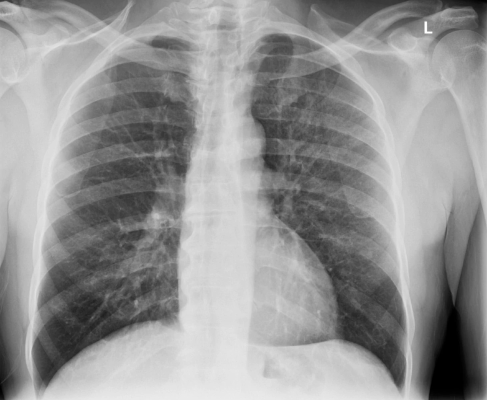
Chest with AI Brightness and Contrast (AIBC), using Helix 2.2 Advanced Imaging Processing.
August 5, 2022 — GE Healthcare released its most advanced fixed X-ray system yet, the next-generation Definium 656 HD. Leading GE Healthcare’s portfolio of fixed X-ray products, this latest generation of the overhead tube suspension (OTS) system delivers consistent, highly automated, efficient exams that impart clinical confidence while simplifying workflow, improving consistency, and reducing errors to help keep radiology departments running smoothly.
X-ray imaging often provides the entry point to diagnostic imaging - accounting for 60% of all imaging studies conducted1. As a result, X-ray technologists, radiologists and radiology administrators are required to manage an ever-increasing caseload, while facing challenges from the heavy lifting, repetitive motions and long hours required that lead to a high work-related musculoskeletal disorders rate2, as well as ‘repeat and reject’ rates as high as 25%3 4 resulting from variability in patient positioning and exam set up.
The Definium 656 HD, featuring the Intelligent Workflow Suite, is a versatile, digital radiographic system powered by GE’s FlashPad HD high resolution detectors and the latest Helix 2.2 advanced image processing software. Combining the highest levels of motorization, automation, assistive intelligence and advanced applications with fastest movement and highest weight capacity in GE Healthcare’s fixed X-ray portfolio5, the system acts like a ‘personal assistant’ to help technologists deliver consistent, efficient, and highly automated imaging exams that impart clinical confidence across the radiology department, while also improving overall patient experience by keeping workflow control in the room for healthcare providers.
To address the day-to-day physical demands of technologists, the next-generation Definium 656 HD helps reduce patient positioning time, physical workload, errors and image retakes through easy-to-use features that speed up the imaging process without compromising image quality, including:
5-axis motorization and auto-positioning provides for fast automatic positioning to any location in the room to speed up workflow and reduce strain on the technologist.
Automated In-Room Workflows enabled by a 12” touchscreen on the tube head console, and AutoRad† software, support manual or automatic workflow control in the room to reduce the number of steps and clicks for technologists.
Intelligent Workflow Suite† leverages 3D camera technology to produce more consistent images while avoiding repeated X-rays before they occur.
To address ‘repeat and reject’ rates that can negatively impact day-to-day clinical operations as well as give radiologists the views they need to make clinical decisions with confidence, the Definium 656 HD also features high-quality detectors, advanced applications, and AI-driven image processing to reduce variability and provides optimal image quality, including:
Cutting-edge 100 um FlashPad HD detectors and the latest Helix 2.2 advanced image processing with on-device artificial intelligence (AI) provides outstanding clarity and exceptional anatomical detail across image types with anatomy-specific image enhancement regardless of variations in dose, patient positioning, field of view and metal.
Auto Image Paste† at the table and wall stand enhanced with AutoSpine supports the fast, precise stitching of long images; and
VolumeRAD† Digital Tomosynthesis provides multi-level image slices for additional diagnostic information.
“At GE Healthcare we strive to provide meaningful technologies and solutions that can help our customers deliver the best possible patient care. With a focus on technologist workflow and efficiency, patient satisfaction, and exam quality, we are elated to introduce the next-generation Definium 656 HD x-ray system,” says Tanya Lancaster, General Manager for Fixed X-ray. “This new offering enables healthcare providers to benefit from the highest levels of motorization, automation, assistive intelligence, and advanced applications offered to date in GE Healthcare’s fixed X-ray portfolio. Not only does this system provide optimal image quality, but it can also reduce the physical workload for technologists and streamline the overall exam workflow. While addressing some of the key challenges technologist and radiologist face, Definium 656 HD can help improve department efficiency along with staff and patient experience. With our next-generation Definium 656 HD, we are excited to deliver our latest in patient-centric innovation to help our customers make every image count.”
For more information: www.gehealthcare.com
References:
1 World Health Organization Report - Communicating Radiation Risks in Pediatric Imaging
2 SHARAN, Deepak, MOHANDOSS, Mathankumar, RANGANATHAN, Rameshkumar, JOSE, Jerrish, & RAJKUMAR, Joshua Samuel. (2014, August 19). Work related musculoskeletal disorders among nurses. 11th International Symposium on Human Factors in Organisational Design and Management (ODAM), CPH Conference (Tietgensgade 65, 1704 København V, Denmark). https://doi.org/10.4122/dtu:2371
3 Emerg Med J 2001;18:263–269 - Diagnostic errors in an accident and emergency department
4 Ann Emerg Med. 1984 Oct;13(10):900-904. Emerg Med J 2001;18(4):263-9
†Denotes optional features
5 GE Healthcare data on file.


 April 24, 2024
April 24, 2024 








